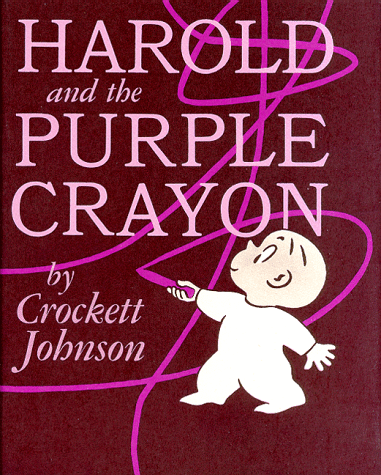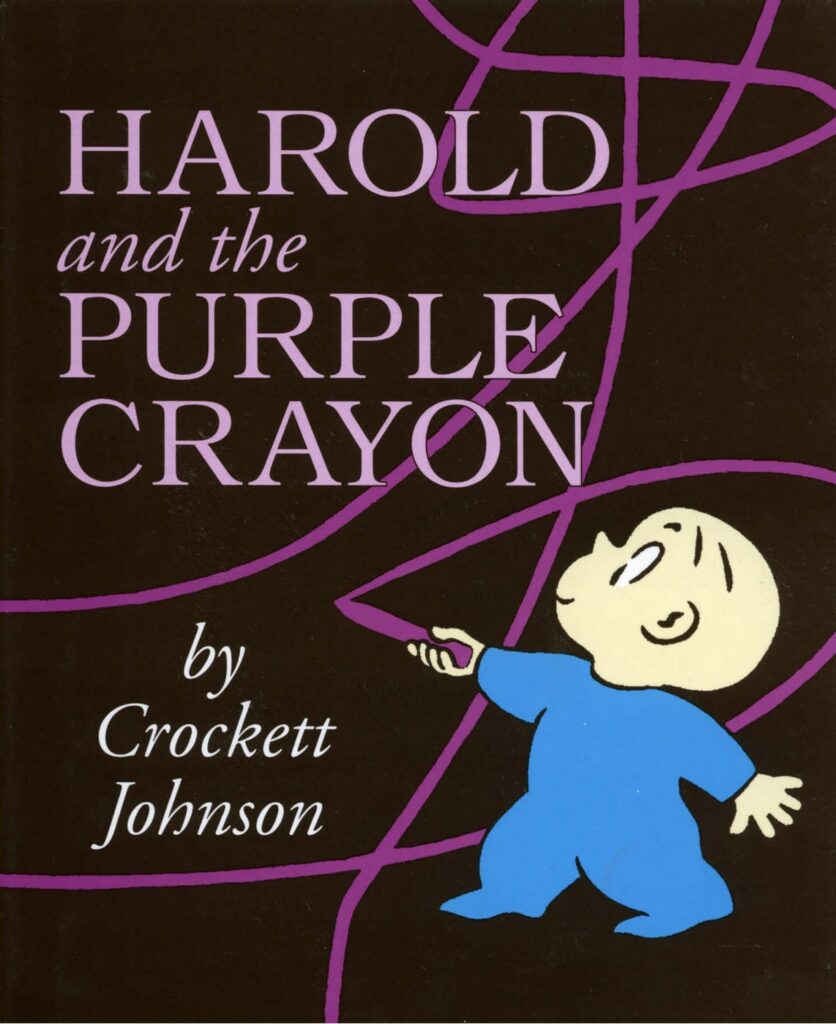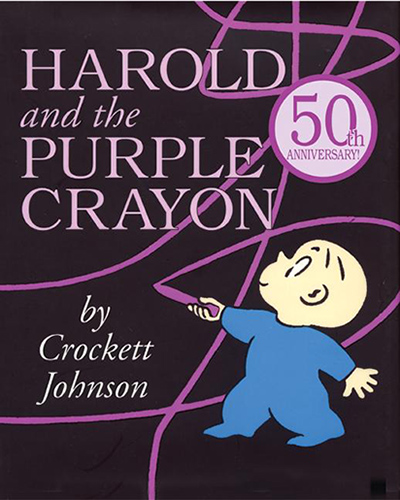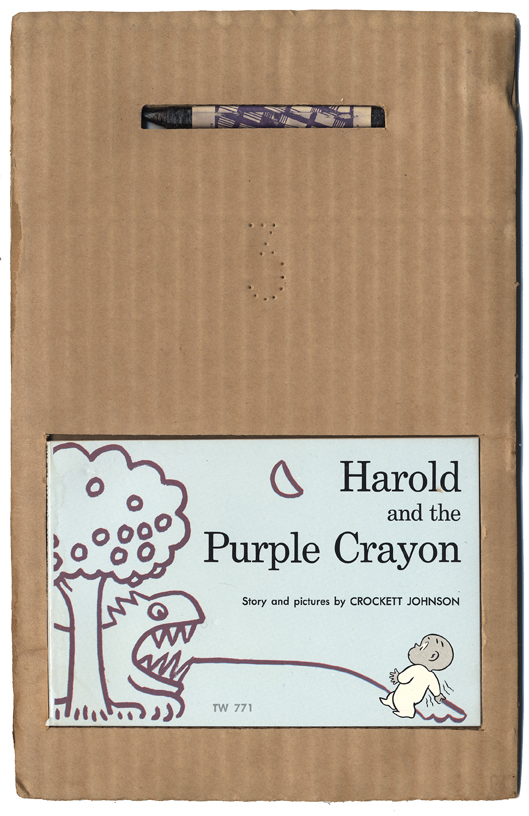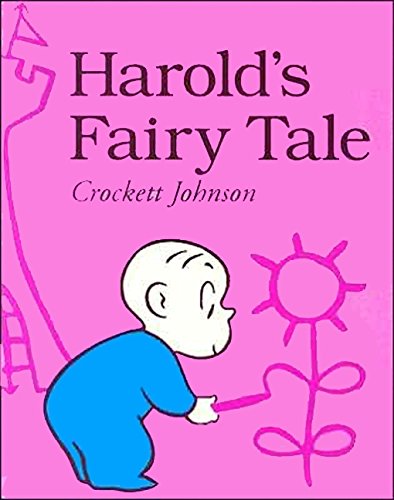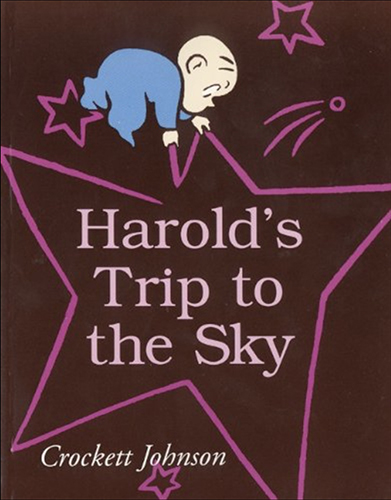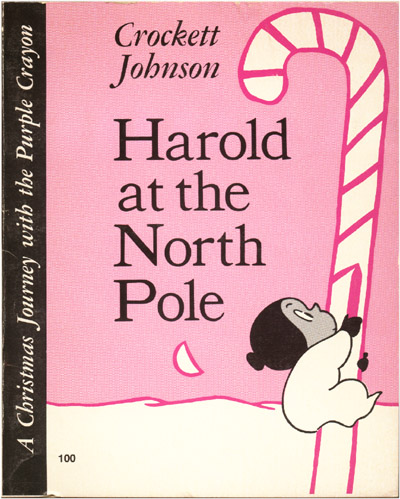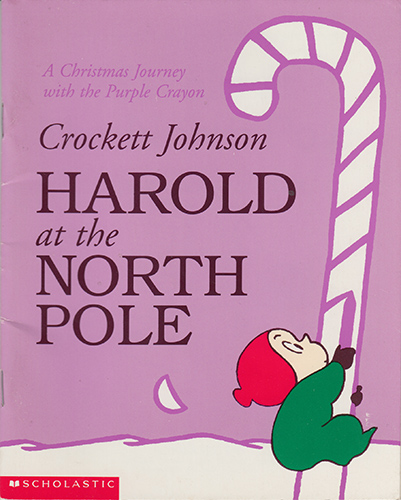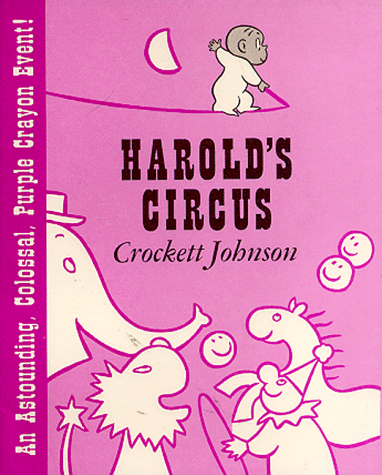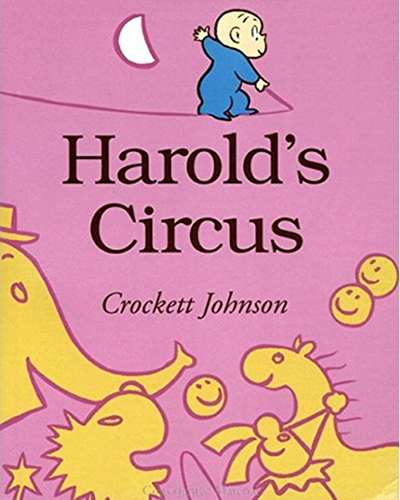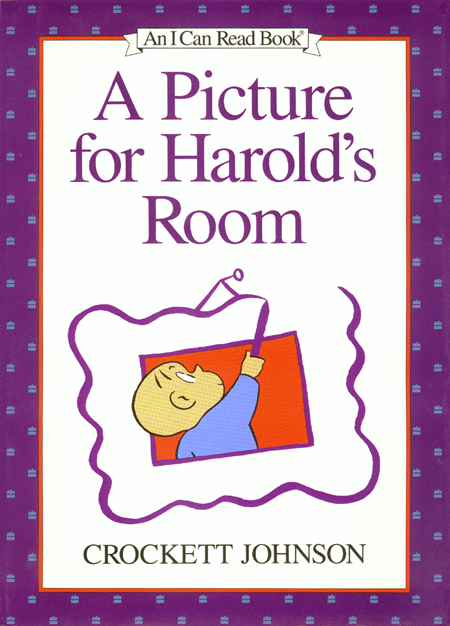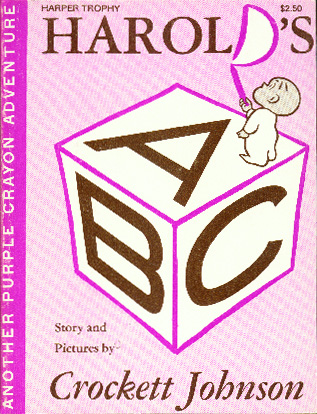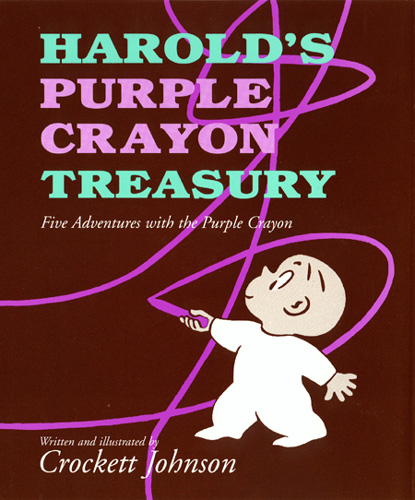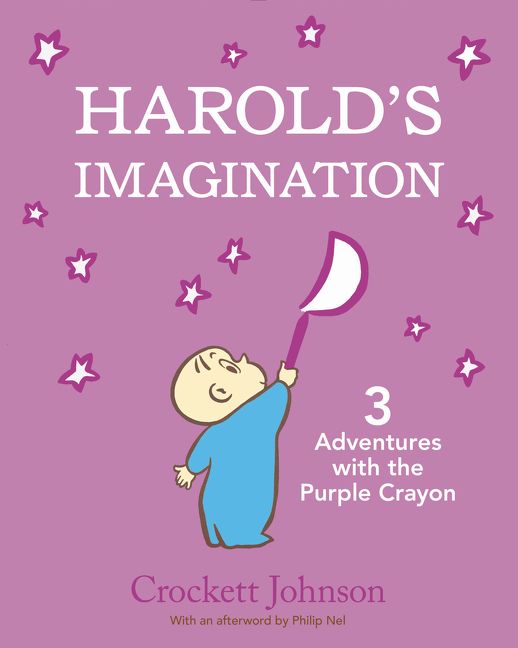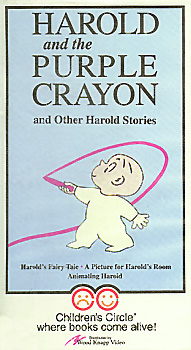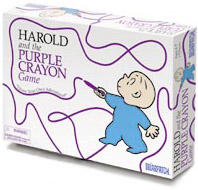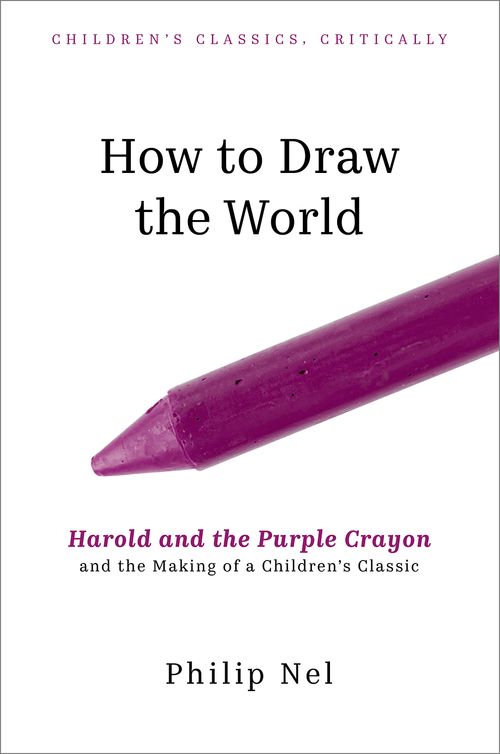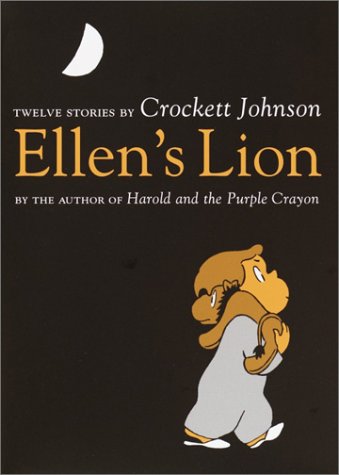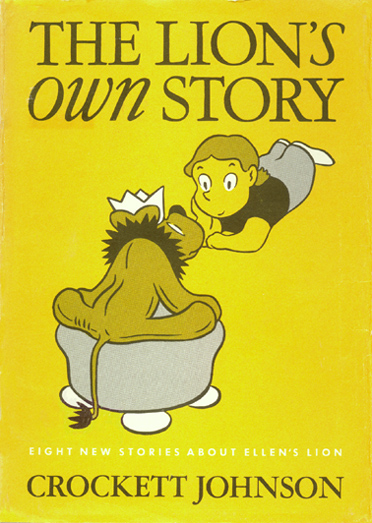Crockett Johnson’s Books: The Harold Series
Harold and the Purple Crayon (1955)
“One evening, after thinking it over for some time, Harold decided to go for a walk in the moonlight.” So begins the first of Johnson’s books about Harold and his purple crayon, and then off he goes, using the crayon to draw a moon and a path to walk on. Leaving the path, he draws himself into a forest, ocean, and balloon, exploring until he’s tired and must find his way to home and bed.
By her own account, legendary children’s book editor Ursula Nordstrom’s “first reaction to Harold was so lukewarm and unenthusiastic”; in a letter dated 15 December 1954, Ms. Nordstrom writes to Crockett Johnson, apologizing for her early impression. She says, “I think it is FINE, and the little changes you made are just perfect. Thanks for the part about the forest, and for all the other little touches” (Nordstrom 83-84). Nordstrom, the director of Harper’s Department of Books for Boys and Girls from 1940 to 1973, edited Harold and many other classics, including The Carrot Seed, E. B. White’s Charlotte’s Web, and Maurice Sendak’s Where the Wild Things Are.
In addition to the English editions represented here, Harold and the Purple Crayon is also available in Spanish, French, Italian, Dutch, German, Hebrew, Swedish, Danish, Finnish, Chinese, and Japanese.
And there is a “Book & Record Set,” produced by Scholastic. Courtesy of Chris Ware, you can see the entire package at left. And, at right, you can see what is in the package: record, record sleeve, book, cardboard, and a purple crayon.
Thanks to Mr. Ware’s generosity, clicking on this sentence will allow you to listen to an mp3 of the record (a reading of Harold and the Purple Crayon, with some music).
Harold’s Fairy Tale (1956)
Taking “his purple crayon and the moon along,” Harold goes for a walk in an enchanted garden. But why is nothing growing in the garden? Harold decides to find out, and he draws a castle so that he may go inside to ask the king. Other “fairy tale” scenes follow, including meeting a wish-giving fairy.
Harold’s Fairy Tale is also available in French, Swedish, Chinese and Japanese.
Harold’s Trip to the Sky (1957)
On his way to get a drink of water, Harold — accompanied by his purple crayon and the moon, of course — finds himself in a desert. Apart from drinking at an oasis, he thinks, “there isn’t much else to do on a desert.” But “then he remembered how the government has fun on the desert. It shoots off rockets.” So he decides to go to the moon, draws himself a rocket, and he’s off on a science-fiction journey through the sky above.
Harold’s Trip to the Sky is also available in French, Dutch and Italian.
Harold at the North Pole (1958)
First published “in a somewhat abbreviated version” in a Good Housekeeping of 1957, this story tells of Harold’s journey to get a Christmas tree before Santa arrives. On Christmas Eve, “in a warm woolen cap and mittens, with his purple crayon and the moon, he set off” for points north. He finds a snowed-in Santa Claus — fortunately, Harold and his purple crayon are always ready to help.
Harold’s Circus (1959)
“One moonlit evening, mainly to prove to himself that he could do it, Harold went for a walk on a tightrope.” From this opening sentence, Harold and his purple crayon tumble into a circus, where they put on a fine performance under the big top.
A Picture for Harold’s Room (1960)
In the sole “I Can Read Book®” of the series, Harold decides that his wall needs a picture, and very soon finds himself in the picture that he’s drawing. Through shifts in perspective, his size changes in relation to the world he’s drawn. Will Harold, aided by his purple crayon, regain his usual size and find his way home?
Harold’s ABC (1963)
The last of Johnson’s books about Harold finds him on a journey through the alphabet. With the help of his purple crayon, Harold transforms each letter into something that starts with the letter. Each picture leads seamlessly to the next one — the cut of cake to drinking from a dipper to visiting an enormous edifice — forming the final purple crayon adventure.
Harold’s ABC is also available in Japanese.
Harold’s Purple Crayon Treasury (1997)
As its subtitle announces, “Five Adventures with the Purple Crayon.” Issued in the larger size favored by HarperCollins since 1998 but published by Barnes & Noble in 1997, this volume contains:
- Harold and the Purple Crayon (1955)
- Harold’s Fairy Tale (1956)
- Harold’s Trip to the Sky (1957)
- Harold’s Circus (1959)
- Harold’s ABC (1963)
Harold’s Imagination (2018)
The largest-sized Harold book to date, this contains:
- Harold and the Purple Crayon (1955)
- Harold’s Fairy Tale (1956)
- Harold’s ABC (1963)
- my Afterword, featuring rare photos, sketches, and interesting information about Crockett Johnson.
Harold and the Purple Crayon and Other Harold Stories (1993)
3 short films (each of a Harold book) and a shorter documentary. Click here for more information.
Harold and the Purple Crayon Game (2001)
Philip Nel, How to Draw the World: Harold and the Purple Crayon and the Making of a Children’s Classic (2024).
This is not by Crockett Johnson — it’s my book about Johnson’s book, published by Oxford University Press in December 2024 (see their site for more details).
Blurbs and Reviews!
- “Philip Nel’s enlightening book reads as though Nel himself were using a magic crayon to explore the importance of creativity. His book is a remarkable biography and autobiography, a creative analysis of Crockett Johnson’s marvelous works. Nel captures their essence and significance for young and old.” — Jack Zipes, author of Ernst Bloch, The Pugnacious Philosopher of Hope and The Original Bambi: The Story of a Life in the Forest
- “Nel praises, properly, Johnson’s purple prose and pictures. A perfect book for reading under a purple moon.” — Lane Smith, Caldecott Honor winner & author and illustrator of the New York Times bestseller It’s a Book
- “Harold drew a world of possibilities for all us childhood dreamers. Now Phil Nel draws us into the life of Harold’s creator–in all its scribbly contours. A delightful portrait.” — Scott McCloud, author of Understanding Comics: The Invisible Art and Making Comics: Storytelling Secrets of Comics, Manga and Graphic Novels
- “Highly verbal and quietly unexpected, the strip is a clear antecedent of the sort of comic situations experienced by Calvin and Hobbes — and the visuals predict Johnson’s own Harold with his purple crayon. Cleverly absurd.” — School Library Journal
- “Johnson’s strict and sharp lines, along with an ever-consistent typeface, give the strip a smooth and accessible appearance, appealing to both kids and adults. This [series] is also filled with the history of the strip and background on Johnson, giving testament to the weirdness and joy of childhood, and the eternal struggle to be yourself.” — Publishers Weekly
Crockett Johnson’s Books: The Ellen Series
Ellen’s Lion: Twelve Stories (1959)
Ellen, a preschooler with an energetic imagination, goes on many adventures with her lion. In contrast to Ellen, the lion is skeptical, unsentimental (“I’m nothing but a stuffed animal. I have no feelings”), and can be reluctant to participate in her games. But, with Ellen, he visits Arabia by train, serves as Ellen’s ailing patient, and becomes her second pair of eyes so that she may safely get a drink of water at night. Despite his claims that he lacks feelings, the lion also serves as a sympathetic ear and sounding-board for Ellen.
According to Lee Bennett Hopkins, this book and its sequel (below) were Johnson’s personal favorites.
Three stories from Ellen’s Lion — “Conversation and Song,” “Two Pairs of Eyes,” and “The New Squirrel” — appear in You Read to Me & I’ll Read to You: 20th-Century Stories to Share (edited by Janet Schulman), published in September of 2001.
The Lion’s Own Story: 8 New Stories about Ellen’s Lion (1963)
Although Ellen is still in nursery school in this book, she seems a bit more experienced than she was in Ellen’s Lion. She still playacts scenes with her lion, but a few of these — “A Kind of Silence” and “Somebody to Blame” — more explicitly address her relationships with adults. As in Ellen’s Lion, grown-ups never enter the world of Ellen and her lion. There, the two paint, participate in a circus, and — in the first tale — tell about the lion’s life before he came to live with Ellen and her family.

